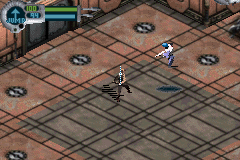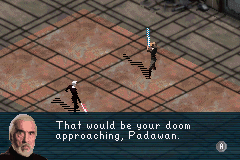Star Wars: The New Droid Army

- Year: 2002
- Developer: Helixe
- Publisher: THQ
- Genre: Action
- Players: 1
- Size: 8MB
This game holds a bit of a special place in my heart. Back in 2003, I received a bright red, Target branded Game Boy Advance, as well as two games. The first was Game & Watch Gallery 4, but the second was this game. Being a huge Star Wars nerd even at that age, I played it quite a lot, until I eventually bought other games, and New Droid Army was relegated to something of a rarely played oddity in my collection.
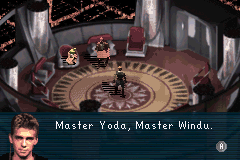

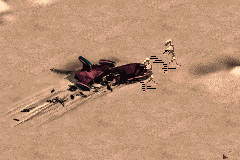
The game is set after Star Wars Episode II, and the story picks up with Anakin, having recovered from his injuries, being sent back to Tatooine to investigate reports of new battle droids, as well as to discover the fate of the contact who sent these reports. You end up completing a few jobs for locals before you eventually find yourself captured and thrown in Jabba the Hutt's dungeons. Here you find Raala Panchar, the contact who initally sent word about the new droids. She tells you that the droids are coming from a planet called Metalorn, and you escape the dungeons with her to contact the Jedi Council and relay this information.
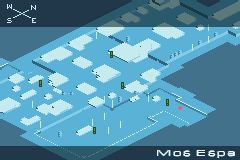
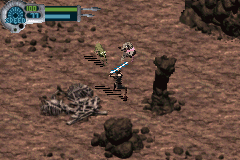
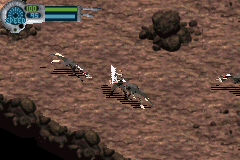
One completely out of nowhere boss fight later, you make contact, only to be told to return to Coruscant to help repel a Separatist invasion. Once there, you fight your way through the Undercity, where you learn that the Separatist plan is to destroy the Jedi Archives. You then rush to the Jedi Temple and defeat the leader of the attack in another relatively plain boss fight.
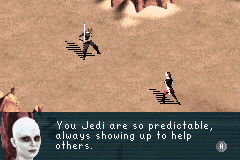
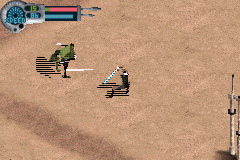
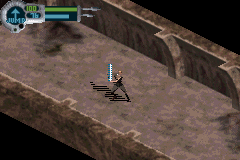
With that success, the council sends you off to Metalorn, and you infiltrate the droid foundry there. You explore the facilities, fight a boss, then discover a random pile of demolition charges, which you use to destroy five reactors to bring down the factory. Another actually rather challenging boss fight later, you kidnap the leader of the company running the factory, detonate the charges, and escape the facility, only to run into Count Dooku. As the final boss fight of the game, Count Dooku goes down much easier than the previous boss, and after a final cutscene with the Jedi Council, the credits roll. The plot isn't particularly involved, but it fits for a handheld original game in an established series.
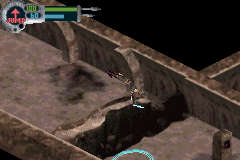
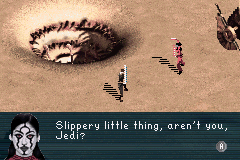

The game itself plays out as an isometric action game. You move through mostly linear levels, fighting various enemies and occasionally talking to NPCs. In combat you can either attack with your lightsaber, or use it to reflect enemy shots, with reflected shots flying wildly unless you time your block perfectly. For attacks you have a standard attack, as well as four combos, activated by holding various directions on the d-pad. The game seems to use a sort of soft lock-on system, where you are locked on the first time you hit an enemy, and subsequent combos will target that enemy specifically. This isn't ever mentioned in the game or the manual, it's just something I noticed while playing.
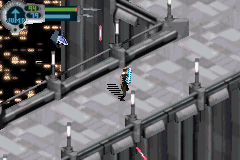
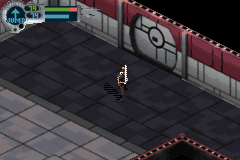
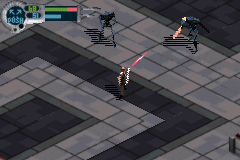
You also have access to 7 force powers, those being speed, jump, push, hide, and meditate. Meditate in particular is useful as it causes you to remain still, but refills your health and force over the course of 10-15 seconds. The environments are relatively bland, with Tatooine being mostly desert, Coruscant being mostly cityscape, and Metalorn being a large sci-fi factory with molten metal lakes strewn about. The latter two especially are laid out in large rooms, connected by tight corridors, and they can start to feel very repetitive pretty quickly.
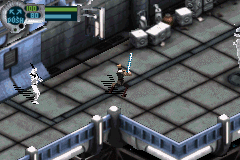

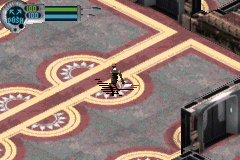
The various levels are also, on the whole, rather dark and monochromatic, which I remember making it quite difficult to see things on my unlit GBA when I first played it. The enemy designs don't help, with a lot of the enemies being various dark shades that blend nicely into the dark backgrounds. This makes the game pretty difficult, especially when later enemies can take big chunks out of your health. You have 100 hit points, and once those are all gone, you start taking damage to your maximum health, decreasing your health pool for the rest of the level. What this means is that I spent a lot of time finding quiet corners to sit and meditate to regain my health, as often as every other room towards the end of the game. Between the constant healing, the repetitive fighting, and the templated design of the latter levels, I can't say it was a very fun game to revisit, and I found myself looking forward to the end before I was two thirds through the game.
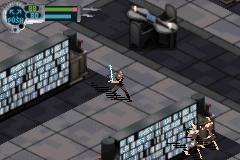
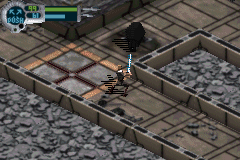

On the technical side, the game seems to use pre-rendered 3D models for the graphics, and they are quite undetailed, seeming to be mostly flat shaded polygons in small numbers. The game also uses a very old technique for shadowing, namely by drawing a shadow in pure black and then quickly flashing alternating lines of the shadow to achive a pseudo-transparency effect. This struck me as odd, as I'm fairly certain the GBA can do native alpha blending transparencies, so I'm not sure why you'd have to do this. Finally, the game doesn't have any sort of save storage, and instead relies on 3 character passwords to choose a level you want to play. This is probably the newest game I've played to rely on passwords, and just adds to the feeling that this game is using old technology on a newer system.
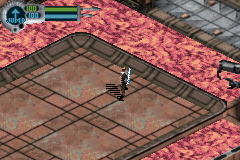
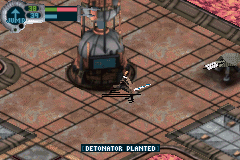
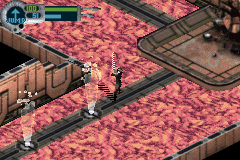
Overall then, this isn't a game I'd recommend to anyone unless you're looking to collect Star Wars video games, but I got a good deal of fun out of it as a child, and even replaying it for this article, I enjoyed my first hour or two with it. Maybe with the addition of some sort of upgrades or something it could be more engaging long term, but as is I'm unlikely to play it again any time soon.
